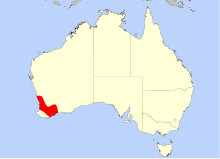Drosera barbigera
| Drosera barbigera | ||||||||||||
|---|---|---|---|---|---|---|---|---|---|---|---|---|

Drosera barbigera |
||||||||||||
| Systematics | ||||||||||||
|
||||||||||||
| Scientific name | ||||||||||||
| Drosera barbigera | ||||||||||||
| Planch. |
Drosera barbigera is a carnivorous plant belonging to the genus sundew ( Drosera ). It belongs to the group of so-called dwarf sundews and is native to southwestern Australia.
description
Drosera barbigera is a perennial herbaceous plant . This rosette-forming dwarf sundew reaches heights of growth of around 5 cm and a diameter of around 5 cm. The stem axis is 2 to 3 cm long and covered with withered leaves of the preseason, only at the tip are the living leaves.
The bud of the stipules is ovate, fringed, 8 mm long and 4 mm in diameter at the base. The stipules themselves are 6 mm long, 4 mm wide and three-lobed. The middle lobe is divided into 3 segments, which in turn are divided into 3 or 4 fringes. The outer lobes are serrated on the edge. At the top and on the edge there are 4 more fringes.
The leaf blades are narrowly elliptical, up to 5 mm long and 1.5 mm wide. The leaf stalks are flattened elliptical, up to 12 mm long, 1 mm wide at the base and taper to 0.5 mm at the leaf blade. They are occasionally covered with cylindrically stalked glandular hairs on the underside.
Flowering time is September. The flower stem is up to 9 cm long and the entire shaft is covered with long, curly, wool-like, cylindrically stalked glands. Their distribution becomes more and more dense towards the tip. The inflorescence is a coil of 5 to 8 flowers on about 1 mm long pedicels. The egg-shaped sepals are 5 mm long and 2 mm wide. The edges and the surface are also covered with cylindrically stalked glands. The tips are toothed and also have glands. The red to light orange petals are black at the base, broadly ovate, 1 cm long and 1 cm wide.
The five stamens are 2 mm long. The anthers are white with red spots and the pollen are white. The black ovary is almost ovate, 0.6 mm long and 0.9 mm in diameter. The 3 black styluses are 1 mm long and 0.1 mm in diameter. The scars are 2 mm long, cylindrical and curved upwards at the end.
The formation of brood scales is typical of dwarf sundewers : the approximately egg-shaped, 1 mm thick brood scales are formed in large numbers from late November to early December and are approx. 2 mm long and 1.7 mm wide.
Distribution, habitat and status
Drosera barbigera is only found in the extreme southwest of Australia. The plant only thrives there on the peaks of laterite hills in white silicon sand and laterite gravel.
Known populations are at Toodyay , York , Lake Grace, and Badgingarra .
Drosera barbigera is not uncommon, threatened or introduced in Western Australia.
Systematics
The name "barbigera" comes from Latin and means "bearded" (barbiger = bearded). Drosera barbigera was described as a species by Jules Émile Planchon as early as 1848 .
literature
- Allen Lowrie : Carnivorous Plants of Australia. Volume 2. University of Western Australia Press, Nedlands 1989, ISBN 0-85564-300-5 , p. 26.
